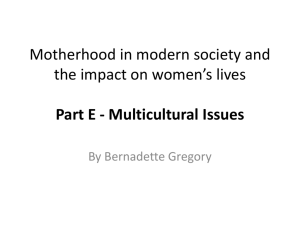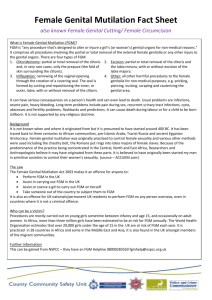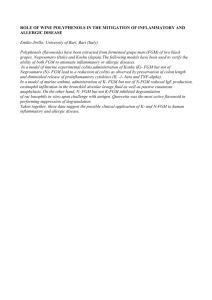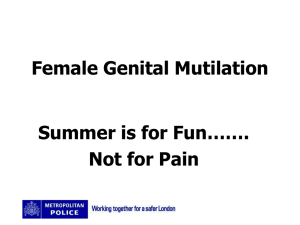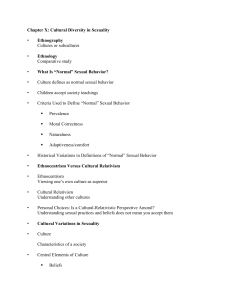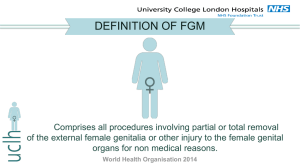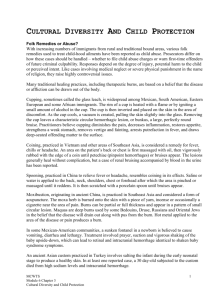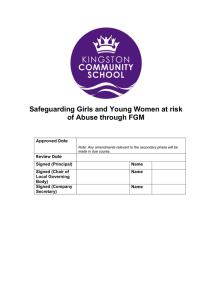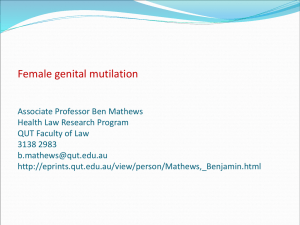Maternity Guideline for the Care of Women who have
advertisement
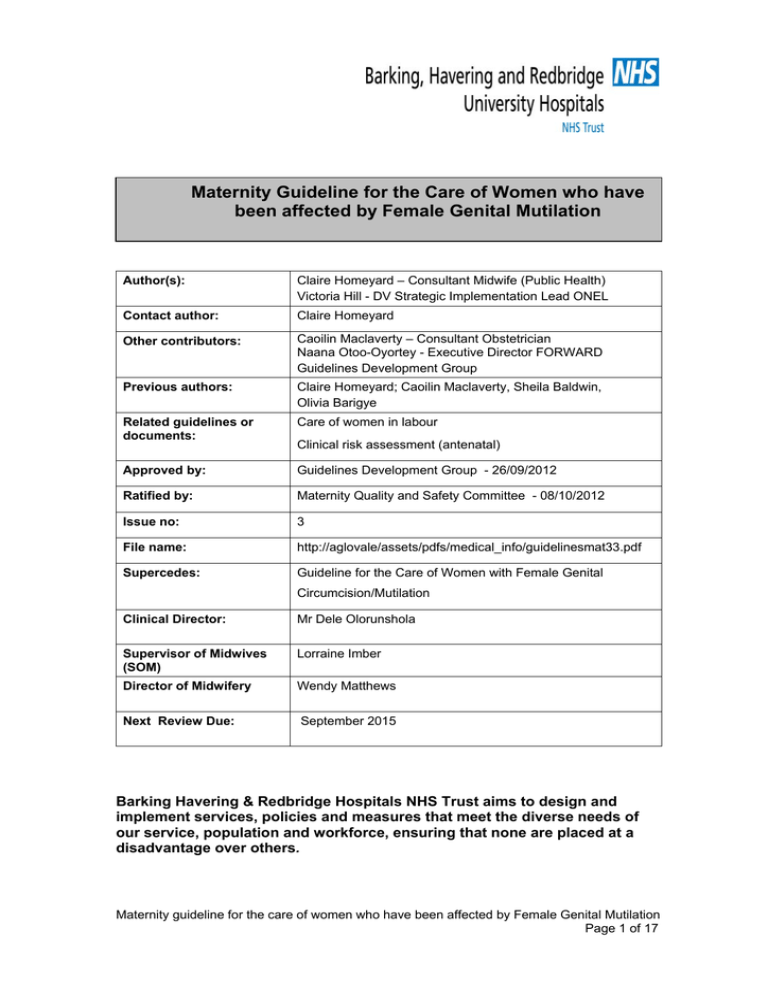
Maternity Guideline for the Care of Women who have been affected by Female Genital Mutilation Author(s): Claire Homeyard – Consultant Midwife (Public Health) Victoria Hill - DV Strategic Implementation Lead ONEL Contact author: Claire Homeyard Other contributors: Caoilin Maclaverty – Consultant Obstetrician Naana Otoo-Oyortey - Executive Director FORWARD Guidelines Development Group Previous authors: Claire Homeyard; Caoilin Maclaverty, Sheila Baldwin, Olivia Barigye Related guidelines or documents: Care of women in labour Approved by: Guidelines Development Group - 26/09/2012 Ratified by: Maternity Quality and Safety Committee - 08/10/2012 Issue no: 3 File name: http://aglovale/assets/pdfs/medical_info/guidelinesmat33.pdf Supercedes: Guideline for the Care of Women with Female Genital Clinical risk assessment (antenatal) Circumcision/Mutilation Clinical Director: Mr Dele Olorunshola Supervisor of Midwives (SOM) Lorraine Imber Director of Midwifery Wendy Matthews Next Review Due: September 2015 Barking Havering & Redbridge Hospitals NHS Trust aims to design and implement services, policies and measures that meet the diverse needs of our service, population and workforce, ensuring that none are placed at a disadvantage over others. Maternity guideline for the care of women who have been affected by Female Genital Mutilation Page 1 of 17 Introduction: These guidelines have been produced to support the policy of asking all women at their booking appointment whether they have experienced any form of surgery to their genitals including female genital mutilation. The World Health Organisation (WHO) defines female genital mutilation as: “all procedures that involve partial or total removal of the external female genitalia, or other injury to the female genital organs for non-medical reasons – WHO 2010 FGM is a form of violence against women and girls and is an abuse of human rights. It is sometimes inappropriately referred to as Female Circumcision or Female Genital Cutting. Some communities use local names for this practice, including the term “sunna”. FGM is not a requirement of any religion. The WHO classification of FGM breaks it down into four types: Type I: Partial or total removal of the clitoris and/ or the prepuce (clitoridectomy). Type II: Partial or total removal of the clitoris and labia minora, with or without excision of the labia majora. Type III: (Infibulation). Narrowing of the vaginal orifice with creation of a covering seal by cutting and appositioning the labia minora and/ or labia majora, with or without excision of the clitoris. Type IV: All other harmful procedures to the female genitalia for non-medical purposes, e.g. pricking, piercing, incising, scraping and cauterising. (NB. the legal status of piercing is unclear in the UK) Ninety percent are either Type I, II or IV, while Type III (infibulation) is only found in 10% of known cases. The single most important risk factor determining whether a woman undergoes a ritual procedure is her country of origin. Any woman who comes from an FGM practicing country falls within the at risk group, especially if the prevalence is high e.g. Somalia, Egypt, Sudan. FGM is practised mainly in Africa (about 30 countries) - the majority of women from Somalia, Sudan, Ethiopia and Sierra Leone will have had some form of FGM, but it is also practised, though to a lesser extent, in the Middle East, India and Indonesia. The global incidence is 130 million with 2 million experiencing a procedure annually. Maternity guideline for the care of women who have been affected by Female Genital Mutilation Page 2 of 17 The law and FGM: The Female Genital Mutilation Act 2003 made it illegal for UK residents (in England and Wales) and permanent residents to practice FGM within or outside in the UK (there is different legislation for Scotland). The act made also made it illegal for someone to take a British Citizen aboard to perform the operation whether or not it is against the law in that country. It is also illegal to assist in carrying out FGM abroad. The law however appears to allow surgery to the external genitalia for comfort, sexual confidence, body image and self esteem (eg. labial reduction surgery). Antenatal Period, booking appointment and FGM enquiry: All clinical staff should be aware of a nominated obstetrician (link-person) in the trust or community with whom cases may be discussed or referred. At BHRUT Ms Maclaverty is the nominated obstetrician. Advice can also be sought from the consultant midwife (public health). Hospitals and clinics in the UK offering specialist FGM services can be found on the FORWARD internet website at: www.forwarduk.org.uk/resources/support/well-woman-clinics It is BHRUT maternity guidance that sensitive enquiry at the booking appointment should be made to determine the FGM status of all women. In addition, it is essential to classify the type and severity of FGM as this will influence maternity and obstetric care. Twenty thousand girls in the UK are also at risk therefore child safeguarding advice should be sought for all daughters thought to be at risk (see page 8 for details on safeguarding responsibilities regarding FGM). All women should be asked sensitively about FGM at booking and the E3 pathway should be followed. See appendix 2 for the FGM E3 pathway. Factors to remember for the booking appointment: • Must be in private – follow the time to talk procedure whereby the first part of the booking is undertaken with the woman on her own • Follow the E3 FGM pathway questions • Where a woman has a hearing impairment, or her first language is not English, arrangements should be made for an interpreter to be present. Wherever possible it should be ascertained from the woman whether the interpreter is suitable. Family members and friends should never be used to interpret interviews of this kind. Download face to face booking form from Intr@net (under further categories), complete and email to #interpreting bookings. The three way phone may be used in circumstances where the language needs of the woman have not been recognised prior to the AN appointment or in an emergency. Maternity guideline for the care of women who have been affected by Female Genital Mutilation Page 3 of 17 If FGM is identified: • Use a diagram or medical photography (with consent). This aids communication with the patient and other clinicians, and limits repetitive examinations • Classify the type of FGM using a preformatted sheet with predrawn diagram (Appendix I) • Include a psychological assessment and referral to a psychologist (via perinatal mental health team) if deemed necessary and agreed upon by the woman Following the assessment, if a woman is a primigravida with type III FGM or it is felt that vaginal examination or delivery will be difficult or impossible she should be referred to Ms Maclaverty’s antenatal clinic for consideration for antenatal deinfibulation while remaining under the care of her original midwife or obstetrician. Antenatal deinfibulation should be offered if vaginal access is inadequate, and to all women with type III FGM. It should ideally be performed around 20 weeks gestation (reduces risk of miscarriage and allows time for healing before birth). Benefits of antennal deinfibulation: • Avoids the need to cut scar tissue in labour • Reduces excessive laceration • Reduces the risk of fetal asphyxia due to delayed crowning at the point of delivery • Reduces the incidence of bacterial vaginosis and associated preterm labour Procedure for antenatal deinfibulation: • Pre-op: MSU , Group & Save • Setting: Minor-op Out-Patient Room or Operating Theatre • The professional undertaking the deinfibulation must have experience • Ensure adequate analgesia (pre & post-op) ¾ usually local/ regional ¾ consider psychological needs (G.A. may rarely be indicated) • Use a blade or scissors for the procedure Maternity guideline for the care of women who have been affected by Female Genital Mutilation Page 4 of 17 • The incision should be made along the vulval excision scar until reaching the point where the urethral meatus is clearly visualised • Closure of the newly opened edges should be brought together with fine absorbable material (Vicryl Rapide) to reduce the likelihood of infection and bleeding and to keep the opposed edges separated • Women should be advised that the flow of urine will change as they will pass urine much quicker and with greater volume. A perceived ‘lack of control’ when emptying the bladder is common • Women should drink plenty of water after the procedure to help dilute the urine and reduce stinging sensation to the area. They should not use soap or detergent (only plain water) to keep the area clean for the first 3-4 days following the procedure • Consider prophylactic antibiotics • Antenatal care continues as for any other woman Intrapartum deinfibulation (offered if vaginal access is adequate) Some women would prefer to have the procedure performed during labour (so as to experience only one lot of pain and trauma). This may be normal practice in their country of origin. Counselling by specialist FGM services may be necessary. Intrapartum care 1. When defibulation has been performed antenatally: • Aim for vaginal birth • Aim for intact perineum • Episiotomy is recommended if inelastic scar tissue prevents progress • Episiotomy when indicated should be medio-lateral Maternity guideline for the care of women who have been affected by Female Genital Mutilation Page 5 of 17 2. When no antenatal deinfibulation (unbooked or elected for intrapartum defibulation): • Birth should be in a unit with immediate access to facilities for emergency obstetric care • The Labour Ward Coordinator must be informed. The woman should be allocated a Senior Midwife • Aim for vaginal birth • Place IV Access; send FBC and Group & Save (risk of PPH) • Provide adequate analgesia to prevent flashbacks to original procedure • Inform Registrar (who is experienced at deinfibulation) or Consultant Obstetrician (if the Registrar does not have experience) • Epidural should be offered, adequate pain relief is essential as vaginal examinations re poorly tolerated, for anterior episiotomy and deinfibulation, and to psychologically reduce flashbacks • Perform deinfibulation in the first or second stage of labour • Informed consent is essential prior to deinfibulation is essential • Infiltrate with local anaesthetic • Perform an anterior midline incision to expose the urethra and clitoris that are beneath the scar tissue. (If uncertain, stop when the urethral meatus is visible) • In the 2nd stage of labour perform the incision at the time of the fetal head crowning • Stretching the fused labia allows a good view of the fusion line and minimises blood loss • Care must be taken to protect the fetal head from laceration WHO recommends suturing raw edges to prevent re-infibulation It is illegal to re-infibulate Maternity guideline for the care of women who have been affected by Female Genital Mutilation Page 6 of 17 Postnatal Care: • Routine care • Debrief if deinfibulation was carried out during labour • Discuss with woman legal status of FGM in the UK (especially if baby girl or girls in the family) • Inform Health Visitor • Inform woman of the link between FGM, pain and health problems in later life • If deinfibulation was carried out in labour, 4-6 week postnatal follow up recommended to assess healing (GP or hospital appointment) • If deinfibulation was carried out in labour , advise to avoid sexual intercourse until healing has occurred and to use lubrication if necessary • Advice / counselling may be required in relation to passing urine, menstruation, sexual health needs • Discuss contraception, IUCD will be a method not previously available • Cervical smear uptake should also be discussed Safeguarding girls and FGM: You have a statutory responsibility to safeguard girls from being abused through FGM. FGM education information (orange FGM: the facts leaflet) www.fco.gov.uk/resources/en/pdf/travel-living-abroad/when-things-gowrong/fgm-leaflet-100310 should be provided to all women identified as having some form of FGM through the booking appointment. The legal and safeguarding implications should be sensitively explained to women as part of the booking appointment. If you have any safeguarding concerns regarding FGM seek advice from the safeguarding midwife, consult and follow the relevant safeguarding procedures (below) and speak with your manager. Multi agency FGM guidelines: www.fco.gov.uk/resources/en/pdf/travel-living-abroad/when-things-gowrong/multi-agency-fgm-guidelines.pdf The London Child Protection Procedures: Safeguarding Children through risk of abuse through Female Genital Mutilation: www.londonscb.gov.uk/fgm/ Maternity guideline for the care of women who have been affected by Female Genital Mutilation Page 7 of 17 References: Momoh, C. (2003) Female Genital Mutilation also known as Female Circumcision. Information for Health Professionals. The African Well Women’s Clinic at Guys and St Thomas Hospital Trust RCM (1998) Female Genital Mutilation (Female Circumcision). Position Paper No 21. RCM. London. Royal College of Nursing (2006) Female Genital Mutilation, An RCN educational resource for nursing and midwifery staff Royal College of Obstetricians and Gynaecologists (2009) Female Genital Mutilation. RCOG Green-Top Guideline No 53. London. Sosa, G Clarke, J (2004) Female Genital Mutilation. The African Well Women Clinic at the Whittington Hospital NHS Trust. A Whittington Hospital Clinical Management Guideline. Toubia, N (1999) Caring for women with circumcision: a technical manual for health care providers. RAINBO. World Health Organisation (2001) Management of pregnancy, childbirth and the postpartum period in the presence of female genital mutilation. London. Department of Health Taskforce on the Health Aspects of Violence Against Women and Children set up a sub group on Harmful Traditional Practices and Human Trafficking. The Royal College of Obstetricians and Gynaecologist - Female Genital Mutilation and its management: www.rcog.org.uk/female-genital-mutilation-and-its-management-green-top-53 Maternity guideline for the care of women who have been affected by Female Genital Mutilation Page 8 of 17 Maternity guideline for the care of women who have been affected by Female Genital Mutilation Page 9 of 17 Maternity guideline for the care of women who have been affected by Female Genital Mutilation Page 10 of 17 Appendix 2 - FGM E3 Pathway Maternity guideline for the care of women who have been affected by Female Genital Mutilation Page 11 of 17 Appendix 3 - FGM Quick Reference Guide Maternity guideline for the care of women who have been affected by Female Genital Mutilation Page 12 of 17 Appendix 4 Female Genital Mutilation resources and information: • Clinical guidelines The Royal College of Obstetricians and Gynaecologist - Female Genital Mutilation and its management: www.rcog.org.uk/female-genital-mutilation-and-its-management-greentop-53 • Weblink to Foreign and Commonwealth Office FGM page www.fco.gov.uk/en/travel-and-living-abroad/when-things-go-wrong/fgm/ • Link to multi agency FGM guidelines www.fco.gov.uk/resources/en/pdf/travel-living-abroad/when-things-gowrong/multi-agency-fgm-guidelines.pdf • Weblink to FCO FGM information leaflet www.fco.gov.uk/resources/en/pdf/travel-living-abroad/when-things-gowrong/fgm-leaflet-100310 • FGM national clinical group www.fgmnationalgroup.org/index.htm • Contact details for specialist FGM support services www.forwarduk.org.uk/resources/support Sources of support and advice on FGM: If you have a concern about FGM happening to someone contact the police as FGM is a crime www.met.police.uk/local/ or contact Metropolitan Police Child Abuse Investigation Command/Project Azure 0207 161 2888, who deal with FGM involving children as this against the law and is a form of child abuse www.met.police.uk/scd/specialist_units/fgm_reward.htm Advice and Brief Intervention Team (ABIT) 0844 600 1018 provide a range of therapies to people over 18 (you don’t have to go through your GP) abit@nelft.nhs.uk Black Women’s Health and Family Support 020 8980 3503, provides information and support to women and communities affected by FGM www.bwhafs.com FORWARD 020 8960 4000, work to improve the health, wellbeing and rights of African women and girls www.forwarduk.org.uk FGM Foreign and Commonwealth Office 0207 008 1500 www.fco.gov.uk/en/travel-and-living-abroad/when-things-go-wrong/fgm/ fgm@fco.gov.uk Maternity guideline for the care of women who have been affected by Female Genital Mutilation Page 13 of 17 Childline 0800 1111 www.childline.org.uk The NSPCC Child Protection Helpline 0808 800 5000 , text 88858 (24 hours a day, 7 days a week, 365 days a year it's free and you don't have to say who you are), a service for adults who are concerned about the safety or welfare of a child. They provide advice and support, and can take action on your behalf www.nspcc.org.uk/helpline Forced Marriage Unit 020 7008 0151 www.fco.gov.uk/en/travel-and-livingabroad/when-things-go-wrong/forced-marriage/ Afruca: Africans unite against Child Abuse 020 7704 2261 info@afruka.org www.afruca.org Contact details for children and adult social care teams: Children’s Social Care Barking & Dagenham Children’s Services Duty Team Office hours 020 8227 3852, 3882, 3860 /Out of Hors 020 8215 3024 www.lbbd.gov.uk/ChildrenAndYoungPeople/ChildProtection/Pages/Home.aspx Havering Children’s Services Duty Team Office hours 01708 433222 / Out of hours 01708 433999 email: duty-referral@havering.gov.uk Redbridge Children’s Services Duty Team Office hours 0208 708 3781 Out of hours 0208 553 5825 www.redbridge.gov.uk/cms/benefits_care_and_health/children_and_families/pr otecting_and_safeguarding.aspx Waltham Forest Direct (ask for Children's Safeguarding and Protection Service - Referral & Assessment Services) Office and out of hours 020 8496 3000 www.walthamforest.gov.uk/index/care/childrenandfamilies/childprotect.htm Safeguarding Adults Barking & Dagenham Adult Services Duty Team Office hours 0208 227 2915 / Out of hours 0208 594 8356 Barking and Dagenham Safeguarding Adults Team Office hours 0208 724 8863, 8858, 8860, 8859 www.barkingdagenham.gov.uk/AdultSocialCare/SafeguardingAdults/Pages/Team.aspx Havering Adult Services Duty Team Office hours 01708 432000 or 01798 433550 / Out of hours 01708 433999 www.havering.gov.uk/Pages/Safeguardingvulnerableadults.aspx Redbridge Adult Services Duty Team Office hours 0208 708 7333 Out of hours 0208 553 5825 www.redbridge.gov.uk/cms/benefits_care_and_health/adult_social_services/se rvices_and_support/safeguaridng_adults_at_risk.aspx Maternity guideline for the care of women who have been affected by Female Genital Mutilation Page 14 of 17 Waltham Forest Office hours 020 8496 3497 or 020 8496 3459 www.walthamforest.gov.uk/index/care/adults-and-olderpeople/adultprotect.htm BHRUT Safeguarding Team 01708503892 or 01708 435000 & ask for Dect 6322) Maternity guideline for the care of women who have been affected by Female Genital Mutilation Page 15 of 17 Appendix 5 Table 1 shows the prevalence and type of FGM by country. (Table 1 - adapted from WHO, 2008 & Lovell, 2000) Maternity guideline for the care of women who have been affected by Female Genital Mutilation Page 16 of 17 Table 2 – Maternities to women affected by FGM Despite the difficulties to obtain accurate figures on the prevalence of FGM in the local community the table below shows the estimated number of maternities to women with FGM and percentage of all maternities to women with FGM (2001 – 2004). Area 2001 number 82 % Redbridge Havering Barking and Dagenham 3.42 2002 % Number 100 4.15 2003 % Number 122 4.74 2004 % Number 167 6.8 Total Number 471 103 3.33 114 3.56 125 3.73 156 4.51 498 6 0.26 8 0.36 15 0.64 17 0.67 47 (Table 2 - taken from - A Statistical Study to Estimate the Prevalence of Female Genital Mutilation in England and Wales Summary Report, Forward 2007) Maternity guideline for the care of women who have been affected by Female Genital Mutilation Page 17 of 17
